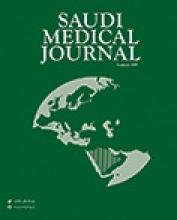Abstract
OBJECTIVES: To develop cephalometric measurements of soft tissue facial profile for a sample of adult Saudi males and females and compare it with European-Americans’ norms for any significant differences.
METHODS: Sixty-one lateral cephalometric radiographs (31 males and 30 females; mean age 23 years) were selected from the archives of cephalometric radiograph files at College of Dentistry, King Saud University, Riyadh, Kingdom of Saudi Arabia between June 2009 and June 2010. Thirteen cephalometric parameters were analyzed electronically using the Dolphin version 10 software according to Legan and Burstone analysis. Descriptive statistics and p-values were calculated for the group comparisons using SPSS program. The statistical significance was determined at the 0.05 level of confidence.
RESULTS: Adult Saudis generally had increased facial convexity associated with retruded mandible, more obtuse lower face-throat angle, increased bimaxillary lip protrusion, greater mentolabial sulcus, decreased vertical lip-chin ratio, and increased maxillary incisor exposure than European-Americans. Saudi females had more obtuse nasolabial angle and decreased lower vertical height-depth ratio than European-American females. Comparisons between the males and females indicated that Saudi females had a reduced lower vertical height-depth ratio, smaller lower lip distance more obtuse nasolabial angle and decreased interlabial gap than males.
CONCLUSIONS: The significant differences in facial structures of Saudis, European-Americans and between the genders should be of a great help for diagnosis of orthodontic and orthognathic surgical cases in Saudi adults.
- Copyright: © Saudi Medical Journal
This is an open-access article distributed under the terms of the Creative Commons Attribution-Noncommercial-Share Alike 3.0 Unported, which permits unrestricted use, distribution, and reproduction in any medium, provided the original work is properly cited.






